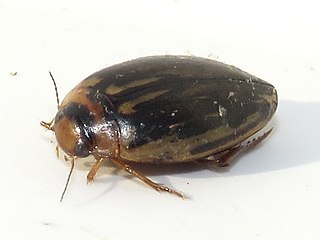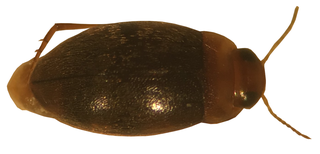
The Dytiscidae – based on the Greek dytikos (δυτικός), "able to dive" – are the predaceous diving beetles, a family of water beetles. They occur in virtually any freshwater habitat around the world, but a few species live among leaf litter. The adults of most are between 1 and 2.5 cm (0.4–1.0 in) long, though much variation is seen between species. The European Dytiscus latissimus and Brazilian Megadytes ducalis are the largest, reaching up to 4.5 cm (1.8 in) and 4.75 cm (1.9 in) respectively. In contrast, the smallest is likely the Australian Limbodessus atypicali of subterranean waters, which only is about 0.9 mm (0.035 in) long. Most are dark brown, blackish, or dark olive in color with golden highlights in some subfamilies. The larvae are commonly known as water tigers due to their voracious appetite. They have short, but sharp mandibles and immediately upon biting, they deliver digestive enzymes into prey to suck their liquefied remains. The family includes more than 4,000 described species in numerous genera.

Dytiscus latissimus is a large species of aquatic beetle in family Dytiscidae. It is native to Europe and considered threatened.

Megadytes is a genus of diving beetles in the family Dytiscidae. They are found in slow-moving or static freshwater habitats throughout most of the Neotropics, ranging from Florida and Mexico, through the West Indies and Central America, to South America as far south as central Argentina. The adult beetles measure about 1.65–4.75 cm (0.6–1.9 in) long depending on the exact species and the largest is also the largest in the family.
Meridiorhantus orbignyi is an extinct species of predaceous diving beetle in the family Dytiscidae. This species was formerly a member of the genus Rhantus.

Coptotomus is a genus of predaceous diving beetles in the family Dytiscidae, the only genus of the subfamily Coptotominae. There are about six described species in Coptotomus, found in North America and the Neotropics.
Hydroporus subpubescens is a species in the family Dytiscidae, in the order Coleoptera ("beetles"). It is found in North America.
Agabetes acuductus is a species of predaceous diving beetle found in the United States and Canada. Its habitat includes wooded wetlands, in the leaf litter of shaded pools, and cattail ponds.
Celina slossoni is a species of predaceous diving beetle in the family Dytiscidae. It is found in North America.
Agabus obliteratus is a species in the family Dytiscidae, in the order Coleoptera ("beetles"). It is found in North America.
Ilybius fraterculus is a species of predaceous diving beetles in the family Dytiscidae. It is found in North America.
Sanfilippodytes compertus is a species of predaceous diving beetles in the family Dytiscidae. It is found in North America.
Agabus ancillus is a species of predaceous diving beetles in the family Dytiscidae. It is found in North America.

Bidessonotus inconspicuus is a species of predaceous diving beetles in the family Dytiscidae. It is found in North America.
Oreodytes scitulus is a species of predaceous diving beetle in the family Dytiscidae. It is found in North America.

Graphoderus liberus is a species of predaceous diving beetle in the family Dytiscidae. It is found in North America.
Megadytes fraternus is a species of predaceous diving beetle in the family Dytiscidae. It is found in North America and the Neotropics.

Cybistrini is a tribe of predaceous diving beetles in the family Dytiscidae. There are 7 genera and 128 described extant species in Cybistrini. The same set is also called Cybistrinae by authors viewing is as a subfamily of Dytiscidae.
Liadroporus is an extinct genus of predaceous diving beetles in the family Dytiscidae. There is one described species in Liadroporus, L. elegans.
Mesoderus is an extinct genus of predaceous diving beetles in the family Dytiscidae. There are at least four described species in Mesoderus.
Mesodytes is an extinct genus of predaceous diving beetles in the family Dytiscidae. There is one described species in Mesodytes, M. rhantoides.








